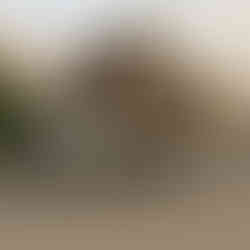Cairo, Egypt
- Rita Selles
- Nov 2, 2019
- 4 min read
Updated: Nov 3, 2019
With a population of 22 million and a week to visit our daughter in this remarkable city, the following pictures give only a glimpse of some of the things I saw and enjoyed.


The Giza pyramids are just a 30-minute drive from downtown Cairo. On a clear day you can see them when you are on a high point in the city.

Just in case the size of the pyramid in first picture doesn't impress you, this picture gives you an idea of just how massive it is!
Back in the city, bakery products spill out on to the sidewalk.
Although bread can be bought in various forms, the most common is the baladi bread or pita. It is sold in grocery stores but also from sidewalk vendors. I was so impressed by these mobile racks of pita! And by the taste of freshly-made pitas!

A tea vendor walks the street, ready to pour a cup for a small price. The vendor bends forward allowing the the tea in the tall container on his back to pour out of a spout you can't see. You will also see electric kettles next to street vendors or security guards so that they can make their own tea whenever they want to. Tea is served in glass cups and it is not uncommon to see security guards, museum security guards, etc. sipping tea while on duty.

This tea stand was on the banks of the Nile, where we took a boat ride.
Traditional cafés are small and often filled just with men, sipping coffee and smoking their hookah pipe. Also common are more American-styled coffee shops and even Dunkin' Donuts.

The skinny lanes of Khan Al Khalili are basically a medieval-style mall. The Khan was built in the 14th century and some of the merchants here are the best smooth-talkers you will ever meet. The shops and stands stock everything from fine jewelry and spices to tacky toy camels. Haggling over a price is the game you are expected to play.
If only my suitcase were larger! The lanterns at the market are outstanding.
Sweets
The first picture is not really a dessert, but a snacking cookie made with dates. It is not that sweet, but still really good.
Top right: Konafa—a pastry with a ricotta cheese and cream filling that is soaked in a sweet syrup. The angel hair pasta-looking top is made by passing pastry through a perforated disc. It is rich, sweet, and quite irresistible.
We saw many locals buying trays of smaller desserts, all variations of nuts, semolina cake, and angel hair pastry. We bought our little tray and were not disappointed. The larger square dessert on the tray, my favorite, is called Basbousa, a semolina cake that is baked and then drenched in floral-scented syrup.
Bottom right: Cardamom Pudding (Mehalabeya)—Milk puddings are a Middle Eastern Classic and a common Egyptian dessert. This cardamom-flavored pudding is made with cream, milk, and lightly sweetened. It is light and not too sweet, a good way to end a meal.
Fresh fruit such as mangos, pomegranates, figs, and guava are abundant. Fresh mango juice is a treat.
Western desserts are available in select shops: cakes, croissants, pain au chocolat, pain au raisin.
Images that make me smile or just represent a very interesting side to Cairo
Top row:
Cars parked in the street often have a "dust-cover". When not covered, you will see people cleaning their car with a dust mop. Cairo is a dusty city!
Water dispenser: cold water, to fill your bottle or to drink from a metal cup. These are found everywhere. Given the heat in Cairo, these are indispensable.
Cairo traffic: I have not seen or heard of traffic like this. It is constant and quiets down by 3am for about an hour or two. Horn honking is the way you get through traffic; a means of communicating with other drivers that you are squeezing past them or turning in front of them. Cars drive about the width of your side-mirror from you. We happily settled for Uber drivers to take us around. For all the driving challenges, at least in my mind, the drivers are very good and it was intriguing to see them get through traffic. With no cross walks and very few traffic lights, pedestrians cross wherever and usually whenever. You just start to cross and weave through lanes of traffic. A good trick is to follow closely on the heals of a local and you'll get across without a scratch.
Middle row:
Loofah sponge seller, a seriously-leaning apartment building, and a overloaded truck with cardboard.
Bottom row:
In another area of the city, these 3-wheeled vehicles were very common. We also saw donkeys pulling wagons, and many, many beat-up white VW vans that serve as mini-buses to transport people around.
A cat, one of hundreds we saw. They can be found just about anywhere, scavenging for food, lounging on the roofs of parked cars, or sharping their claws on a motorcycle tire.

Koshary, one of Egypt's national dishes, is a hearty dish composed of rice, lentils, chickpeas, pasta, and topped with a spicy tomato sauce and fried onions. Garlic vinegar and a hot sauce are optional. It is a common street food and is so good that we had it twice.

These little packages are filled pitas. The top left one, "ful", is a pita filled with mashed spiced fava beans and tahina. This is a typical breakfast item for Egyptians, although it can be eaten throughout the day. Falafel and meat-filled pitas are also very common, served in restaurants and as street food.

Feteer is a flaky Egyptian layered pancake, consisting of many thin layers of dough and ghee. We enjoyed ours after an afternoon in the Khan (market). They come both as savory and sweet. Our savory was filled the local roumy cheese, a hard, salty cheese. Our dessert pancake was filled with hazelnuts and honey. Sweet and crunchy.
I learned later on that this Egyptian specialty dates back to the time of the pharaohs when it was used as an offering for the Gods in Egyptian temples.

Our last evening in Cairo was partially spent on a "felucca", Egypt's ancient broad-sail boat. Being on the Nile River, just as the sun is setting, and being away from the noise of the city, was the perfect way to end our trip.
I did not mention mosque visits or Coptic Cairo, or our visit to the Egyptian Museum, worth an entire post!




























































